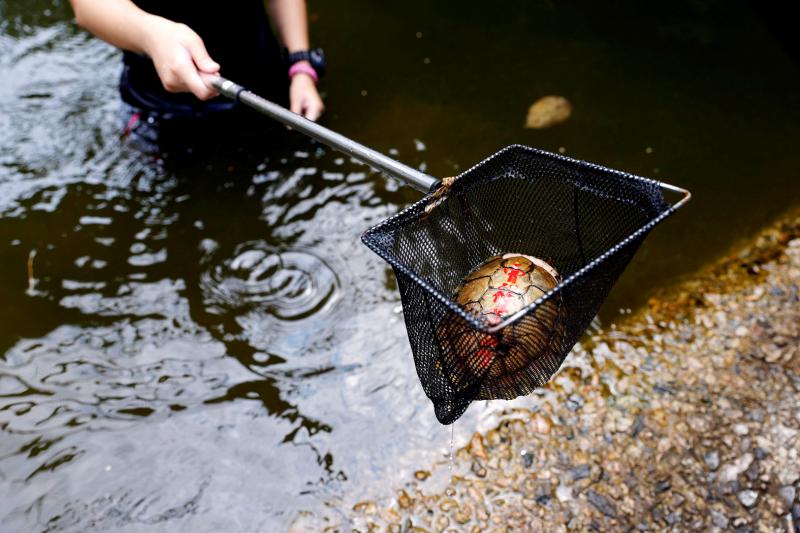At a drainage pool near a popular hiking site in Hong Kong’s rural Tai Po district, a group of volunteers armed with snorkels, nets and gloves wade through the muddy water to find dozens of turtles left there by residents.
The red-eared slider turtles were released into the wild through a practice known as “mercy release” — a concept rooted in a Buddhist belief that freeing animals brings good fortune.
But many animals are being intentionally captured and sold just to be set free, animal experts said, while the turtles often get hurt or even die after being left in waterways.

Photo: Reuters
There are also concerns that the release of the red-eared slider, which is not native to Hong Kong, could disrupt the local ecosystem and pose a risk to public health.
Thousands of animals are affected every year and scores are likely to be released in May leading up to the Buddha’s birthday on May 19, conservation experts said.
“It’s not suitable for these turtles to live in places like these catchwater drains or ponds because they are not local Hong Kong species,” said Sean Lai, who runs a concern group for abandoned turtles.

Photo: Reuters
“If they used to be cared for by humans, they won’t be able to hunt in the wild, they may not be able to catch the fish, shrimp, or food they need, then they’ll starve to death. Or due to the change of weather, they might freeze to death or die from the heat.”
Lai said at least 28 out of the over 80 turtles his group found in the same drainage outlet this year were dead. Some had “mercy release” written on their shells in Chinese characters.
He said his volunteers were taking care of more than 60 injured turtles — from treating skin infections to broken shells — and that the animals would be put up for adoption when they returned to health.
“Hong Kong is facing a serious situation of people mercy releasing turtles. A lot of religious devotees would buy a large number of turtles and release them into rivers, streams, beaches, and country parks,” Lai said.
MULTIPLE RISKS
Other animals commonly involved in mercy releases in Hong Kong include frogs, insects, baby birds and fish, said Paul Crow, a senior conservation officer at Kadoorie Farm and Botanic Garden, which focuses on species conservation and ecosystem restoration in Hong Kong and southern China.
Releasing a foreign animal could not only damage the local ecosystem but could pose a risk to public health down the line, Crow said.
“Potential disease, bacteria, virus, parasites from other countries, from the collection sources are all getting dumped without screening, or without ... consideration of the public health risk as well.”
Hong Kong’s Agriculture, Fisheries and Conservation Department said that while mercy release is not illegal, it could be detrimental to animal welfare and spread diseases. If the practice causes unnecessary suffering to animals, it may also breach the city’s legislation on prevention of cruelty to animals, it said.
The department said it would continue to implement education and publicity to promote animal welfare.
The Hong Kong Buddhist Association said it did not urge people to release animals and that some “inappropriate practices” had caused physical harm to animals, threatened the environmental balance and led to adverse criticism.
“We hope more people can understand the traditional way of mercy release is not the only way to help animals,” it said, recommending alternatives such as “adopting a vegetarian lifestyle and protecting and enhancing wildlife habitats.”

Dec. 16 to Dec. 22 Growing up in the 1930s, Huang Lin Yu-feng (黃林玉鳳) often used the “fragrance machine” at Ximen Market (西門市場) so that she could go shopping while smelling nice. The contraption, about the size of a photo booth, sprayed perfume for a coin or two and was one of the trendy bazaar’s cutting-edge features. Known today as the Red House (西門紅樓), the market also boasted the coldest fridges, and offered delivery service late into the night during peak summer hours. The most fashionable goods from Japan, Europe and the US were found here, and it buzzed with activity

During the Japanese colonial era, remote mountain villages were almost exclusively populated by indigenous residents. Deep in the mountains of Chiayi County, however, was a settlement of Hakka families who braved the harsh living conditions and relative isolation to eke out a living processing camphor. As the industry declined, the village’s homes and offices were abandoned one by one, leaving us with a glimpse of a lifestyle that no longer exists. Even today, it takes between four and six hours to walk in to Baisyue Village (白雪村), and the village is so far up in the Chiayi mountains that it’s actually

These days, CJ Chen (陳崇仁) can be found driving a taxi in and around Hualien. As a way to earn a living, it’s not his first choice. He’d rather be taking tourists to the region’s attractions, but after a 7.4-magnitude earthquake struck the region on April 3, demand for driver-guides collapsed. In the eight months since the quake, the number of overseas tourists visiting Hualien has declined by “at least 90 percent, because most of them come for Taroko Gorge, not for the east coast or the East Longitudinal Valley,” he says. Chen estimates the drop in domestic sightseers after the

It’s a discombobulating experience, after a Lord of the Rings trilogy that was built, down to every frame and hobbit hair, for the big screen, to see something so comparatively minor, small-scaled and TV-sized as The Lord of the Rings: The War of the Rohirrim. The film, set 183 years before the events of The Hobbit, is a return to Middle-earth that, despite some very earnest storytelling, never supplies much of an answer as to why, exactly, it exists. Rohirrim, which sounds a little like the sound an orc might make sneezing, is perhaps best understood as a placeholder for further cinematic